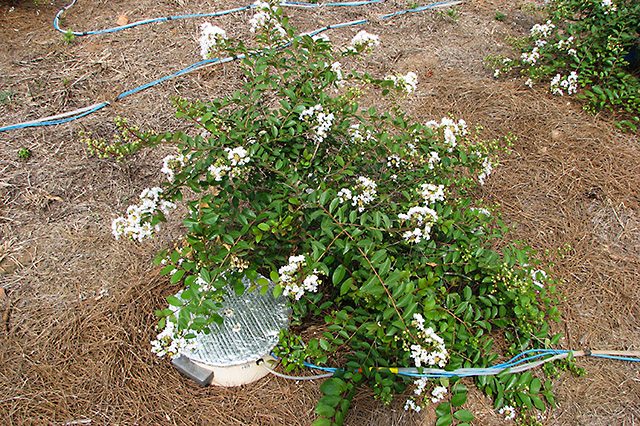
A carbon-sampling device placed beside a crepe myrtle plant measures carbon escaping from the soil.
(Photo by Barry Dorman.)
With spring here, U.S. Department of Agriculture (USDA) scientists in Alabama have some timely advice for gardeners and homeowners who buy shrubs or trees.
Their insight comes from a cooperative study with Auburn University scientists focused on the effects of pine bark and other types of potting media used with many potted shrubs and woody ornamentals.
Pine bark is considered an industry standard as a potting media, but it is a byproduct of logging and timber operations, the supply of which can fluctuate. There are also a number of wood-based alternatives.
George Runion and Stephen Prior, who are based at the USDA Agricultural Research Service’s (ARS) National Soil Dynamics Laboratory in Auburn, Alabama, compared pine bark’s capabilities for storing carbon in the soil with the alternatives. Storing carbon in the soil keeps it from being released into the atmosphere as carbon dioxide, a greenhouse gas, and helps the soil retain water and nutrients.
The researchers planted three woody ornamentals in different potting media (pine bark, clean chip residue and “Whole Tree,” a wood-based product used to grow plants sold at nurseries and retail outlets). After the plants had taken root, the researchers transplanted them into outdoor plots and measured the amounts of carbon in the soil for three years.
The results showed that the pine bark media was the most effective at storing carbon in the soil, stockpiling up to 50 percent more carbon in the first year and roughly 100 percent more three years later. The ornamentals also grew just as well in the pine bark as in the two alternatives.
According to Runion, the pine bark should store carbon equally well in different types of soils, in different parts of the country, and with different types of shrubs and small potted trees.
Read more about this research in the May 2017 issue of AgResearch.










